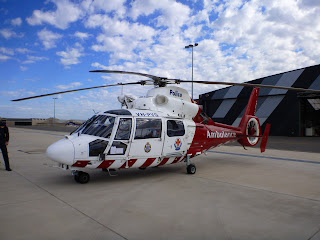
Pesci's Seafood and Mediterranean Restaurant
http://www.pescis.com.au/Menu: http://www.pescis.com.au/food/pescismenu
Open for lunch and dinner daily.
Mains around $30 but some seafood dishes are more expensive. Paella $39.
We sampled four dishes at our table:
The ubiquitous child's bowl of chips (unremarkable).
The ubiquitous child's bowl of chips (unremarkable).
Paella $39.50
Seafood flavoured spanish risotto served in a "paellera" with fresh local fish, prawns, calamari, scallops, chicken and chorizo. Garnished with black mussels and Moreton Bay Bugs.
Seafood flavoured spanish risotto served in a "paellera" with fresh local fish, prawns, calamari, scallops, chicken and chorizo. Garnished with black mussels and Moreton Bay Bugs.
Local Leader Tiger Prawns $35.00
Sashimi style or grilled served with saffron rice and seasonal vegetables, lemon butter sauce.
Lamb Rack $36.00
Oven roasted lamb rack with rosemary and garlic. Served with roasted vegetables and chef's own jus.
We also shared a jug of Sangria (pleasant, fruity and light).
Oven roasted lamb rack with rosemary and garlic. Served with roasted vegetables and chef's own jus.
We also shared a jug of Sangria (pleasant, fruity and light).
I'm told that the Leader Prawns were acceptable, but perhaps one prawn short of a good meal.
An elderly relative, normally a modest eater at best, made short work of the rack of lamb and polished off the while thing. This is probably the best compliment you can possibly have for this particular dish!
A sibling and I both had the Seafood Paella. I have eaten a lot of very ordinary paellas in the past, but this one was good. I had pronounced to the table when ordering that making a good paella is a test of a chef's skill, and this one did not disappoint.
It is cooked and served on an individual basis on a low dinner-plate sized black cast iron dish, which keeps it warm for a long time. When it came to the table it was clear that it had been cooked in the pan and all the fluid had been absorbed into the risotto, creating plump and tasty golden grains of rice. The rice at the bottom of the pan was slightly caramellised, with a more intense flavour. Interspersed amongst the rice was a generous amount of chopped chicken and fish and small and tender calamari rings together with several medium-sized prawns. All of these ingredients were nicely cooked and appropriately tender. As well on the top of the dish could be found two black mussels, two scallops and two pieces of Moreton Bay Bug. The mussels were tender and not at all chewy or stringy (to my relief, as I am generally not a great fan of mussels) and the scallops were not overcooked but perhaps a little on the thin side. The Moreton Bay Bug was a little dry. Possibly the star of the dish was the sliced spicy chorizo sausage, which appeared perhaps to have been char-grilled on the outside.
The wait staff (both French) were helpful and attentive, and our young guest was allowed to touch one of the blue crabs in the nearby tank who were somewhat grimly awaiting their fate. The largest one disappeared while we were there and later reappeared on a nearby table.
We had an outside table but there are some tables available inside the restaurant.
It was a pleasant dining experience and I would definitely recommend the Paella!
An elderly relative, normally a modest eater at best, made short work of the rack of lamb and polished off the while thing. This is probably the best compliment you can possibly have for this particular dish!
A sibling and I both had the Seafood Paella. I have eaten a lot of very ordinary paellas in the past, but this one was good. I had pronounced to the table when ordering that making a good paella is a test of a chef's skill, and this one did not disappoint.
It is cooked and served on an individual basis on a low dinner-plate sized black cast iron dish, which keeps it warm for a long time. When it came to the table it was clear that it had been cooked in the pan and all the fluid had been absorbed into the risotto, creating plump and tasty golden grains of rice. The rice at the bottom of the pan was slightly caramellised, with a more intense flavour. Interspersed amongst the rice was a generous amount of chopped chicken and fish and small and tender calamari rings together with several medium-sized prawns. All of these ingredients were nicely cooked and appropriately tender. As well on the top of the dish could be found two black mussels, two scallops and two pieces of Moreton Bay Bug. The mussels were tender and not at all chewy or stringy (to my relief, as I am generally not a great fan of mussels) and the scallops were not overcooked but perhaps a little on the thin side. The Moreton Bay Bug was a little dry. Possibly the star of the dish was the sliced spicy chorizo sausage, which appeared perhaps to have been char-grilled on the outside.
The wait staff (both French) were helpful and attentive, and our young guest was allowed to touch one of the blue crabs in the nearby tank who were somewhat grimly awaiting their fate. The largest one disappeared while we were there and later reappeared on a nearby table.
We had an outside table but there are some tables available inside the restaurant.
It was a pleasant dining experience and I would definitely recommend the Paella!
















































